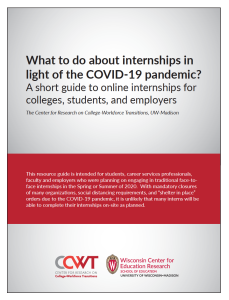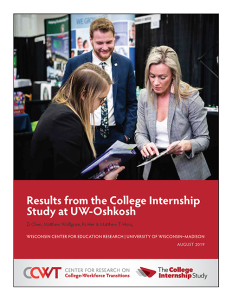Filter by Category:
Search
Year
- Category: Research Reports
- Clear Filters
 Hora, M.T. (2020). What to do about internships in light of the COVID-19 pandemic? A short guide to online internships for colleges, students and employers. Center for Research on College-Workforce Transitions. UW-Madison.
Hora, M.T. (2020). What to do about internships in light of the COVID-19 pandemic? A short guide to online internships for colleges, students and employers. Center for Research on College-Workforce Transitions. UW-Madison.
Abstract: This resource guide is intended for students, career services professionals, faculty and employers who were planning on engaging in traditional face-to-face internships in the Spring or Summer of 2020. With mandatory closures of many organizations, social distancing requirements, and “shelter in place” orders due to the COVID-19 pandemic, it is unlikely that many interns will be able to complete their internships on-site as planned.
Wolfgram, M., Vivona, B., & Akram, T. (2020). On the intersectional amplification of barriers to college internships: A comparative case study analysis (WCER Working Paper No. 2020-4).
Abstract: Research shows that college internships yield academic, economic, and professional benefits. However, the ability to locate and participate in internships is not equitable across all student demographic and socioeconomic spectrums. There are multiple complex barriers to internship participation for students with low socioeconomic status, and for those who are minoritized by race, gender, or other factors. Contextual factors such as finances, work responsibilities, travel, and gendered familial obligations intersect to amplify the challenges to internship participation. In the research described in this paper, the research team conducted focus groups among 24 students from a comprehensive federally designated Hispanic-Serving Institution. The team explored the data using intersectionality theory and comparative case study analysis; and in this paper we present a comparative case study analysis of five students in our study. We determined that delineation of barriers into types, such as financial, social, and cultural, runs the risk of misconstruing students’ actual experience when they struggle to access internships and other educational opportunities.
 Smolarek, B. B., Vang, M., & Wolfgram, M. (2019). HMoob American Undergraduate Students at University of Wisconsin’s 4-Year Comprehensive Colleges – Background, Enrollment Statistics, and Graduation Trends. Center for Research on College-Workforce Transitions, UW-Madison.
Smolarek, B. B., Vang, M., & Wolfgram, M. (2019). HMoob American Undergraduate Students at University of Wisconsin’s 4-Year Comprehensive Colleges – Background, Enrollment Statistics, and Graduation Trends. Center for Research on College-Workforce Transitions, UW-Madison.
Summary: The Paj Ntaub Research Team is a collective of HMoob American student activists and scholars at the Center for Research on College-Workforce Transitions (CCWT) housed within the Wisconsin Center for Education Research (WCER) at the University of Wisconsin-Madison (UW-Madison). This report was compiled by members of the Paj Ntaub team and draws on institutional research data provided by the University of Wisconsin System Office of Policy Analysis and Research. We combine this data with U.S. Census and other demographic data reports to provide a profile of the basic higher educational statistics for HMoob American students in the UW System Universities.
The HMoob started arriving in Wisconsin shortly after the end of the Vietnam War in 1975 and continued to be resettled until about 2006, after the closing of the last refugee camp in Thailand. It was not until 2006, however, that UW-Madison, and in 2008 the rest of the UW System schools, began offering “Hmong” as an ethnic category on their application for admissions. Therefore, the data presented in the report only includes students who self-identified as “Hmong” since 2008. This report is the first time that disaggregated HMoob student data has been publicly reported as the UW system typically combines data on Hmong students with larger categories such as “Asian,” Southeast Asian,” or “Targeted Minority” when publishing publicly available data digests and other reports concerning students.
 Zi Chen, Matthew Wolfgram, Pa Her & Matthew T. Hora (2019). Results from the College Internship Study at University of Wisconsin-Oshkosh
Zi Chen, Matthew Wolfgram, Pa Her & Matthew T. Hora (2019). Results from the College Internship Study at University of Wisconsin-Oshkosh
Abstract: This report includes preliminary findings from the first round of data collection for The College Internship Study, which is a mixed-methods longitudinal study of internship programs at the University of Wisconsin Oshkosh.
The study includes an online survey of students in the second half of their academic programs (n=221), focus groups with students who have and who have not had an internship experience (n=19), interviews with career advisors and faculty (n=11), and interviews with area employers involved in internship program administration (n=15). The research questions guiding this study focus on how stakeholders conceptualize and define the idea of internships, participation rates by certain demographic characteristics, and the relationship between internship program structure and student outcomes.
This report concludes with recommendations for specific steps that students, faculty and staff at UW-Oshkosh, and employers who supervise interns can take to increase participation rates, access, and program quality for internship programs in Oshkosh area in Wisconsin.
